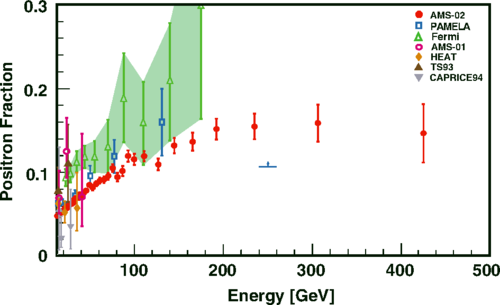News & Events
AMS latest results
The AMS-02 experiment onboard the International Space Station, has observed the fraction of cosmic ray positrons to electrons and positrons up to the highest energies ever, some 500 GeV per particle. The latest results combine observations of 10.9 million positrons and electrons, and give us the best handle yet on the spectral properties of this mysterious astrophysical signal.
In the century since Victor Hess first observed the phenomenon of Cosmic Rays (CRs) in 1911, physicists have established that this ever-present bath of radiation consists of high-energy elementary particles: protons, electrons and their antiparticles, as well as heavier nuclei and antinuclei, produced in energetic astrophysical processes such as supernovae. Among these particles is a small component of antimatter: these are particles produced from rare collisions between cosmic rays as they zip through the galaxy, yielding so-called "secondary" particles. Since these collisions become rarer as energy increases, the ratio of antiparticles to particles is expected to fall with rising energy; a prediction borne out by detailed calculations and simulations.
Fig 1. The positron fraction above 10 GeV as measured by recent experiments
Since 2008, however, astrophysicists have observed a surprising feature in the ratio of positrons (anti-electrons) to electrons plus positrons, known simply as the positron fraction. Above energies of 10 GeV (about 10 times the mass of the proton if it were converted to kinetic energy), the positron fraction actually starts to rise, and continues to rise until 130 or so GeV, the highest energy reachable by the instrument. This behaviour was first seen with the PAMELA satellite, and later confirmed by NASA's Fermi/LAT telescope, and unless standard calculations are modified, it is not consistent with the “secondary production” scenario.
If there is indeed a new primary source, of antimatter, it would have to be relatively nearby: electrons and positrons that are this energetic lose energy over distances of less that a few thousand lightyears. Astronomers have suggested the presence of a nearby pulsar, which could create such a positron flux. Some particle physicists have suggested a dark matter interpretation, however deeper analyses over the past few years have strongly disfavoured this interpretation, since such theories also predict excesses in antiprotons and gamma rays from the galactic centre which are not seen. Finally, the excess may simply be due to a misunderstanding of how particles propagate in the complex turbulent magnetic fields of the Galaxy.
What is clear is that this new observation by AMS-02, coupled with our understanding of the Galaxy requires some new source of antimatter in our neighbourhood. Otherwise, we may need to move away from the simplified diffusion models of cosmic ray propagation that may be misleading us about the nature of the interstellar medium.AMS
Source: https://journals.aps.org/prl/pdf/10.1103/PhysRevLett.113.121101





